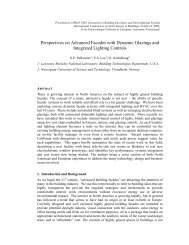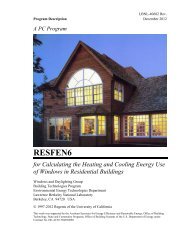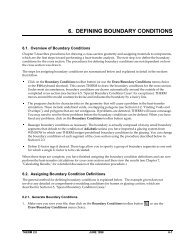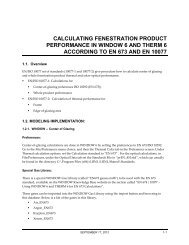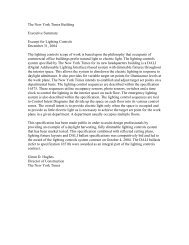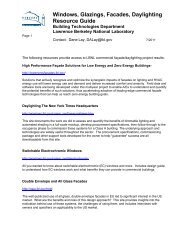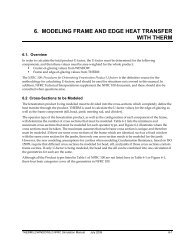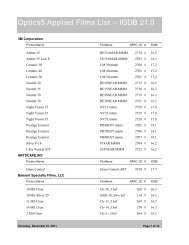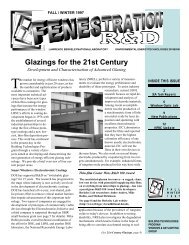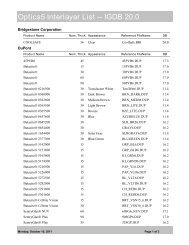Moving from Niche to Mainstream Markets - Windows and ...
Moving from Niche to Mainstream Markets - Windows and ...
Moving from Niche to Mainstream Markets - Windows and ...
Create successful ePaper yourself
Turn your PDF publications into a flip-book with our unique Google optimized e-Paper software.
Similarly for the lighting controls. Let's talk about what are the basic components <strong>and</strong>what can we do <strong>to</strong> try <strong>to</strong> save or reduce costs. We have the digital addressable dimmingballasts themselves. We have the pho<strong>to</strong>sensors. We have the wiring <strong>and</strong> we have thecommissioning. So for the ballasts themselves, we found out <strong>from</strong> our lighting designerthat DALI existed. We said, "Well, what's it [DALI] worth?" So they called up acompany that makes digital dimming ballasts <strong>and</strong> asked them, "What's the cost of a DALIdimmable ballast?" And they said, "Oh, it's about $130 each, something like that." Andso they brought that back <strong>and</strong> then they <strong>to</strong>ok out the drawings <strong>and</strong> they looked at howmany light sensors <strong>and</strong> light fixtures there were <strong>and</strong> they said, "Oh, you have 20,000fixtures <strong>and</strong> a normal ballast would cost, let's say $20 <strong>and</strong> the dimmable is $130. So it's a$110 premium, multiply that by 20,000, that's your premium." I said, "What a bunch ofbaloney." Why do I need <strong>to</strong> pay people <strong>to</strong> give me that kind of analysis? That doesn'tmean anything. Is that how you buy ballasts when you buy 20,000 of them? Of coursenot! So we started working on the marketplace <strong>and</strong> we tried <strong>to</strong> transform the marketplace<strong>to</strong> change these ballasts <strong>from</strong> a luxury product <strong>to</strong> a commodity. And I think that's whatwe've done. It still costs more. I didn't get my big hairy audacious goal all the way, but itstill costs more, but we got it down <strong>to</strong> about a $30 premium on our job, which is prettyamazing. That was the first job that bought a big batch of these. The next job <strong>and</strong> thenext job is going <strong>to</strong> keep driving prices down, because there's going <strong>to</strong> be competitionamongst these ballast manufacturers. And I know there's been a lot of work done onthem since August of 2004. So we should be able <strong>to</strong> find better pricing than I have.Okay, the pho<strong>to</strong>sensors themselves we talked about, piggyback them on thecommunication loop, saved a pile of wiring costs. Communication wiring, the DALIwiring <strong>and</strong> the power wiring are allowed <strong>to</strong> be in the same raceway. This is not a controlloop in a 0-10 volt world. This is a communication pair of conduc<strong>to</strong>rs <strong>and</strong> those areallowed <strong>to</strong> sit in the same raceway as the power <strong>to</strong> the fixture. So we have the 277 volts<strong>and</strong> the DALI conduc<strong>to</strong>rs, the communication conduc<strong>to</strong>rs, pulled at the same time by theelectricians as one pull. They just combine the ground, the hot, the neutral <strong>and</strong> the DALIconduc<strong>to</strong>rs, pulled them all at once. That saved a secondary set of electricians comingthrough the space <strong>and</strong> pulling all of the DALI conduc<strong>to</strong>rs as a separate operation. A big,big savings there. It's not the cost of the wires. The wires are almost insignificant. It'sthe cost of the labor <strong>to</strong> pull <strong>and</strong> terminate them at the fixtures. At least we have thepulling costs. We still have <strong>to</strong> terminate the extra two wires on every ballast, unders<strong>to</strong>od.5



